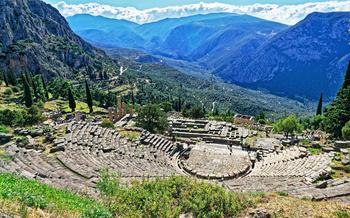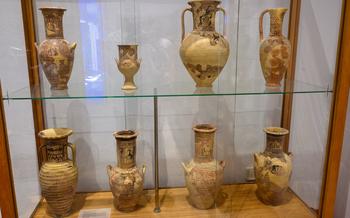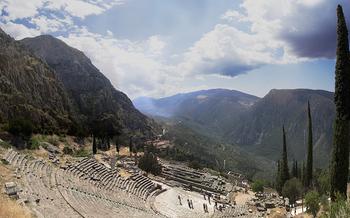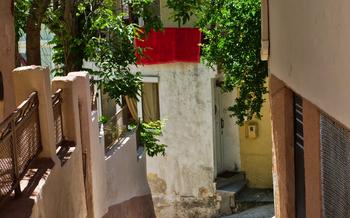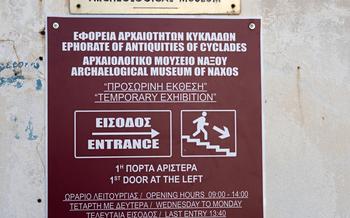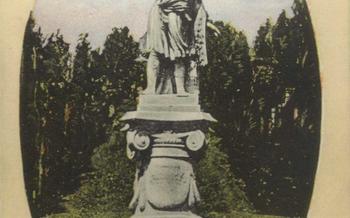
Archaeological Museum of Syros
- A Journey Through Time: Exploring the Museum's Exhibits
- Unveiling the Enigmatic Cycladic Figurines
- The Allure of Ancient Jewelry
- Remarkable Pottery and Sculptures
- Glimpsing into Daily Life in Ancient Greece
- Navigating the Museum's Layout
- Engaging with Interactive Exhibits
- Learning from the Experts: Guided Tours and Workshops
- Personal Insights
- Capturing Memories: Photography at the Museum
- Museum Amenities and Accessibility
- Planning Your Visit: Essential Information
- Syros: A Cultural and Historical Gem
- The Museum's Contribution to Archaeological Research
- Insider Tip: Discover the Hidden Courtyard
A Journey Through Time: Exploring the Museum's Exhibits
The Archaeological Museum of Syros takes visitors on a captivating journey through the island's rich history, showcasing artifacts from various periods that span millennia.
The Cycladic and Early Bronze Age collection offers a glimpse into the earliest inhabitants of Syros and the surrounding Cycladic islands. These artifacts, dating back to 3000 BC, include exquisite marble figurines, pottery, and tools that provide insights into the daily lives and artistic expressions of these ancient civilizations.
The Geometric and Archaic periods, from 1000 to 500 BC, are represented by a stunning array of pottery, bronze statuettes, and jewelry. These artifacts showcase the development of artistic styles and techniques, as well as the influence of mainland Greece and the Near East on Syros.
The Hellenistic and Roman periods, from 323 BC to 330 AD, left a significant mark on the island. The museum houses a collection of sculptures, mosaics, and coins from this era, reflecting the island's prosperity and cultural exchange with the wider Mediterranean world.
Finally, the Byzantine and medieval periods, from 330 to 1537 AD, are represented by a variety of artifacts, including icons, manuscripts, and pottery. These relics offer a glimpse into the island's Christian heritage and its role as a cultural and religious center during the Byzantine Empire.
Unveiling the Enigmatic Cycladic Figurines
The Archaeological Museum of Syros houses a remarkable collection of Cycladic figurines, offering a glimpse into one of the most intriguing and enigmatic civilizations of the ancient world. These iconic marble sculptures, dating back to the 3rd millennium BC, have captivated the world with their simplicity, elegance, and mysterious expressions.
The Cycladic civilization flourished in the Aegean Sea, with Syros being one of its major centers. Their figurines, typically depicting nude female figures with folded arms and schematic facial features, have become synonymous with this ancient culture. While their exact purpose and significance remain a subject of debate, these figurines are believed to have played a role in religious rituals, fertility rites, or as grave goods.
The museum's collection includes a wide range of Cycladic figurines, showcasing the diversity and evolution of this art form. From the early, abstract forms to the more refined and detailed later pieces, these figurines provide a fascinating glimpse into the artistic and cultural development of the Cycladic civilization.
One of the highlights of the collection is a rare and exquisite figurine known as the "Lady of Syros." This beautifully preserved piece, dating back to the Early Cycladic II period (2700-2500 BC), stands out for its intricate details, including a delicate necklace and a distinctive hairstyle.
The mystery surrounding the Cycladic figurines adds to their allure. Were they representations of goddesses, ancestors, or simply objects of everyday life? The lack of written records from this period leaves many questions unanswered, inviting visitors to contemplate the lives and beliefs of these ancient people.
The Allure of Ancient Jewelry
The Archaeological Museum of Syros boasts an impressive collection of ancient jewelry, showcasing the exquisite craftsmanship and cultural significance of adornments from various eras. Gold and silver pieces gleam in intricate designs, adorned with precious gemstones and delicate filigree work.
Among the highlights are elaborate necklaces, bracelets, earrings, and rings, each serving a unique purpose in ancient Greek society. Gold jewelry was reserved for the elite, symbolizing wealth and power, while silver pieces were more common among the middle class.
The symbolism associated with jewelry extended beyond aesthetics. Necklaces often incorporated pendants in the form of protective amulets, while rings bore personal seals or symbols of deities. Earrings were believed to ward off evil spirits, and bracelets symbolized unity and strength.
One particularly captivating piece is a gold necklace adorned with intricate granulation work and featuring a central pendant depicting the goddess Artemis. The level of detail and artistry is simply breathtaking, showcasing the incredible skill of ancient goldsmiths.
Another highlight is a silver bracelet featuring a row of tiny bells. The delicate tinkling sound produced by the bells was believed to bring good luck and ward off negative energy.
These precious artifacts offer a glimpse into the personal adornments and cultural beliefs of ancient Greeks. They serve as tangible reminders of the enduring allure of jewelry as a form of self-expression, protection, and status.
Remarkable Pottery and Sculptures
The Archaeological Museum of Syros houses an impressive collection of pottery and sculptures that span various eras of ancient Greek history. The Neolithic period is represented by impressive handmade pottery with simple geometric designs. As we move through the centuries, the pottery evolves, showcasing the increasing skill and artistry of the ancient Greeks. Geometric pottery, characterized by intricate linear patterns, gives way to the more elaborate Black-figure and Red-figure techniques. These exquisitely painted vases depict mythological scenes, everyday life, and historical events, offering a glimpse into the minds and world of the ancient Greeks.
The museum's sculpture collection is equally remarkable, featuring masterpieces from different eras. From the Archaic period, we find kouros and korai, statues of young men and women with a distinctive frontal pose and serene expressions. The Classical period is represented by finely crafted marble sculptures that exhibit a mastery of anatomy and movement. These sculptures, often depicting gods, goddesses, and heroes, embody the ideals of beauty and harmony that defined classical Greek art.
One particularly striking sculpture is a marble statue of a young athlete, known as the "Ephebe of Syros." This life-size statue, dating back to the 4th century BC, captures the essence of athleticism and youthful vigor. The Ephebe's muscular physique, graceful stance, and serene expression embody the ideals of physical perfection that were highly valued in ancient Greece.
These remarkable pottery and sculptures offer a tangible connection to the past, allowing visitors to appreciate the artistic achievements and cultural values of the ancient Greeks. Whether you are an art enthusiast, a history buff, or simply someone who appreciates beauty, the Archaeological Museum of Syros will leave you in awe.
Glimpsing into Daily Life in Ancient Greece
One of the most fascinating aspects of the Archaeological Museum of Syros is the opportunity it provides to gain insights into the daily lives of the ancient Greeks. The museum houses a wealth of artifacts that shed light on domestic life, agriculture, and trade during various periods of Greek history.
Among the most intriguing artifacts are those related to food preparation and consumption. Visitors can marvel at intricately decorated pottery vessels used for cooking, serving, and storing food. Mortars and pestles, querns for grinding grain, and amphorae for transporting liquids offer a glimpse into the culinary practices of the ancients.
The museum also showcases tools and implements used in agriculture, such as plowshares, sickles, and hoes. These artifacts hint at the importance of farming in ancient Greek society, where agriculture was a primary source of livelihood for many people.
Trade and commerce were essential aspects of ancient Greek life, and the museum's collection includes a variety of objects related to these activities. Weights and measures, coins, and seals provide evidence of the sophisticated economic systems that existed in ancient Greece.
By examining these artifacts, visitors can gain a deeper understanding of the daily routines, occupations, and economic activities that shaped the lives of the ancient Greeks. These objects offer a tangible connection to the past, allowing us to imagine what life was like for ordinary people in ancient Greece.
Navigating the Museum's Layout
The Archaeological Museum of Syros is a treasure trove of ancient artifacts, and navigating its layout can be both exciting and overwhelming. To make the most of your visit, here's a clear and concise map of the museum's galleries:
- Ground Floor:
- Gallery 1: Cycladic and Early Bronze Age artifacts, including the enigmatic Cycladic figurines.
-
Gallery 2: Discoveries from the Geometric and Archaic periods, showcasing pottery, jewelry, and sculptures.
-
First Floor:
- Gallery 3: Hellenistic and Roman treasures, including exquisite gold and silver jewelry, pottery, and sculptures.
- Gallery 4: Byzantine and medieval relics, offering a glimpse into Syros' rich Christian heritage.
To prioritize your time, here are some highlights of each section:
- Cycladic and Early Bronze Age Gallery: Don't miss the iconic Cycladic figurines, representing some of the earliest examples of human representation in art.
- Geometric and Archaic Gallery: Marvel at the Geometric pottery, characterized by its simple yet striking geometric patterns, and the exquisite Archaic sculptures.
- Hellenistic and Roman Gallery: Admire the intricate gold and silver jewelry, reflecting the craftsmanship and artistry of ancient Greek goldsmiths.
- Byzantine and Medieval Gallery: Explore the collection of Byzantine icons, religious artifacts, and medieval pottery, shedding light on Syros' Christian past.
To avoid crowds and ensure a peaceful visit, consider visiting during the off-season or on weekdays. The museum is typically less crowded in the mornings, offering a more intimate experience.
For a truly immersive experience, I recommend hiring an audio guide or booking a guided tour. The tours are available in multiple languages and provide fascinating insights into the artifacts and the history of Syros.
Engaging with Interactive Exhibits
The Archaeological Museum of Syros goes beyond static displays, offering visitors an immersive experience through interactive exhibits. Multimedia presentations and touchscreens bring ancient artifacts and historical events to life, making learning fun and engaging for visitors of all ages. Step into a virtual reality tour of ancient Syros, where you can explore the streets and monuments of a bygone era.
Hands-on activities, such as pottery workshops and interactive puzzles, allow visitors to engage with the museum's collection in a tactile and memorable way. Children can dress up in ancient Greek costumes, play educational games, and participate in storytelling sessions that bring mythology and history alive.
During my visit, I was particularly drawn to the interactive timeline that showcased the evolution of Syros' culture and civilization. By simply swiping a screen, I could navigate through different historical periods, exploring key events and achievements in detail. The interactive map of the island allowed me to trace the footsteps of ancient travelers, uncovering hidden ruins and forgotten landmarks.
These interactive elements not only enhanced my understanding of Syros' past but also created a lasting impression that made my museum experience truly unforgettable.
Learning from the Experts: Guided Tours and Workshops
Enhance your visit to the Archaeological Museum of Syros by taking advantage of the guided tours and workshops offered. Knowledgeable guides bring the museum's collection to life, providing insights into the history and significance of the artifacts. Guided tours are available in multiple languages, ensuring that visitors from all over the world can benefit from this immersive experience.
The museum also offers a range of educational workshops for visitors of all ages. These workshops provide hands-on opportunities to learn about ancient Greek culture and history. Children can participate in pottery-making or jewelry-making workshops, while adults might enjoy lectures on specific periods or topics.
To make the most of your visit, book your guided tour or workshop in advance. This will ensure that you have a spot and can choose the topic or language that interests you. I highly recommend participating in a guided tour, as it will deepen your understanding and appreciation of the museum's treasures.
Personal Insights
During my visit, I had the privilege of joining a guided tour led by an enthusiastic and knowledgeable archaeologist. She shared fascinating stories and insights about the artifacts, bringing the ancient world to life. Her passion for her subject was infectious, and I left the tour with a newfound appreciation for the museum's collection.
I also participated in a pottery-making workshop, which was a fun and educational experience. I learned about the techniques used by ancient Greek potters and created my own unique piece of pottery. It was a great way to connect with the past and gain a deeper understanding of ancient Greek craftsmanship.
Capturing Memories: Photography at the Museum
Photography enthusiasts will delight in the opportunity to capture the timeless beauty of the Archaeological Museum of Syros through their lenses. Photography is permitted within the museum, allowing visitors to immortalize their journey through history. However, flash photography is strictly prohibited to protect the delicate artifacts from damage.
To capture the best shots, it's advisable to adjust your camera settings accordingly. Natural light streams through the museum's windows, providing ample illumination for your photographs. Experiment with different angles and perspectives to create dynamic compositions. Whether you're drawn to the intricate details of a Cycladic figurine or the grandeur of a marble statue, your photographs will serve as lasting mementos of your visit.
Personal Anecdote:
During my visit to the museum, I was particularly captivated by a stunning bronze statue of a young athlete. The play of light and shadow across its muscular form created a sense of movement and energy that I wanted to capture perfectly. I spent several minutes adjusting my camera settings and angles until I found the ideal composition. The resulting photograph is one of my favorites from the entire trip, and it now hangs prominently in my living room, reminding me of the awe-inspiring beauty I encountered at the Archaeological Museum of Syros.
Museum Amenities and Accessibility
The Archaeological Museum of Syros is committed to providing a welcoming and accessible environment for all visitors. The museum features a range of amenities to enhance your visit, including restrooms, a cloakroom, and a well-stocked museum shop where you can purchase souvenirs, books, and replicas of artifacts.
For visitors with disabilities, the museum offers several accessibility features to ensure a comfortable and enjoyable experience. Wheelchair ramps and elevators provide access to all levels of the museum, and tactile maps and audio guides are available for visually impaired visitors. Additionally, the museum staff is trained to assist visitors with disabilities and provide any necessary assistance.
The museum also offers guided tours in multiple languages, including English, French, German, and Italian. These tours are led by experienced guides who provide insightful commentary on the museum's collection and the history of Syros. To ensure a spot on a guided tour, it is advisable to book in advance, especially during peak tourist season.
With its comprehensive amenities and accessibility features, the Archaeological Museum of Syros strives to create an inclusive and engaging experience for all visitors.
Planning Your Visit: Essential Information
To fully appreciate the treasures of the Archaeological Museum of Syros, it's crucial to plan your visit wisely. The museum is open from Tuesday to Sunday, with hours varying seasonally, so check their website or inquire locally for the most up-to-date information. Admission fees are modest and offer great value for the wealth of artifacts on display.
Reaching the museum is a breeze, whether you're exploring Syros on foot or by public transport. It's conveniently situated in the heart of Hermoupolis, within easy walking distance from the city's main square and the picturesque harbor. If you're arriving by bus, simply hop off at the central bus station and follow the signs to the museum.
Once you've arrived, take some time to familiarize yourself with the museum's layout. A map is usually provided at the entrance, highlighting the various galleries and exhibits. It's worth noting that photography is generally permitted within the museum, but flash photography is strictly prohibited to protect the delicate artifacts.
To make the most of your visit, consider combining it with other attractions in Syros. The island offers a wealth of historical and cultural treasures, including the imposing Vaporia neighborhood with its majestic mansions, the scenic Ano Syros village perched atop a hill, and the picturesque beaches dotting the coastline.
After your museum visit, take a leisurely stroll along the charming streets of Hermoupolis, lined with traditional tavernas and inviting cafes. Indulge in the local delicacies, such as the aromatic loukoumades (honey-drizzled doughnuts) or the savory san michali (fried cheese with tomato sauce), and soak in the vibrant atmosphere of this captivating island.
Syros: A Cultural and Historical Gem
Syros is a captivating island, rich in history and cultural heritage. Beyond the Archaeological Museum, visitors can explore a wealth of other fascinating attractions and landmarks. The island's capital, Ermoupolis, boasts stunning neoclassical architecture, epitomized by the imposing Town Hall and Apollo Theater. The Vaporia neighborhood, with its colorful fishermen's houses, offers a glimpse into Syros' maritime past. The island's beautiful beaches, such as Galissas and Kini, provide idyllic settings for relaxation and swimming. For a taste of local life, visitors can stroll through the vibrant markets, sample the delicious cuisine at traditional tavernas, and experience the vibrant nightlife.
My personal encounter with Syros' hidden gems was particularly memorable. While wandering through the picturesque Ano Syros neighborhood, I stumbled upon a charming little church dedicated to Agios Nikolaos. Its serene atmosphere and intricate iconography left a lasting impression. Another highlight was discovering the Syros Industrial Museum, which showcased the island's rich industrial heritage through fascinating exhibits and interactive displays. These experiences deepened my appreciation for Syros' diverse cultural tapestry.
The Museum's Contribution to Archaeological Research
The Archaeological Museum of Syros is not only a repository of ancient artifacts but also an active hub of archaeological research. The museum collaborates with local and international institutions to conduct excavations and research projects that shed light on the rich history of Syros and the Cyclades. These endeavors have unearthed valuable insights into the island's prehistoric settlements, Classical-era cities, and medieval fortifications.
One of the museum's ongoing projects focuses on the excavation of the ancient city of Halandriani, located on the island's west coast. This site, dating back to the 3rd millennium BC, has yielded significant finds, including well-preserved buildings, pottery, and other artifacts that provide glimpses into the daily lives of the island's early inhabitants.
Another important research initiative involves the study of the Geometric and Archaic periods in Syros. Through excavations and analysis of artifacts, the museum's team has gained valuable insights into the island's transition from the Bronze Age to the Classical era. The discoveries from this period have helped to reconstruct the social, economic, and cultural dynamics of Syros during a time of significant transformation.
The museum's research activities extend beyond Syros to encompass the broader region of the Cyclades. In collaboration with other institutions, the museum has participated in underwater surveys and excavations that have yielded important finds, such as shipwrecks and submerged settlements. These discoveries have contributed to a better understanding of maritime trade and cultural exchange in the Aegean Sea during antiquity.
The Archaeological Museum of Syros stands as a testament to the island's rich and diverse past. Through its ongoing research initiatives, the museum plays a crucial role in preserving and studying Syros' archaeological heritage, contributing to a deeper understanding of the island's place in the broader context of ancient Greek history and culture.
Insider Tip: Discover the Hidden Courtyard
Tucked away within the Archaeological Museum of Syros lies a hidden gem that often goes unnoticed by visitors. The courtyard, accessible through a discreet doorway, is an oasis of tranquility and a treasure trove of historical charm.
As you step into the courtyard, you'll be transported back in time. The walls are adorned with ancient inscriptions and fragments of architecture, while the air is filled with the scent of jasmine and bougainvillea. The courtyard was once part of a Byzantine monastery, and its serene atmosphere still lingers today.
Take a moment to sit down on one of the stone benches and soak in the tranquility. Let your mind wander as you gaze upon the ancient artifacts that surround you. The courtyard is a reminder of the rich history of Syros, and it's the perfect place to escape the hustle and bustle of the museum and reflect on the wonders you've seen.
I stumbled upon the courtyard by chance during my first visit to the museum. I was immediately captivated by its beauty and historical significance. I spent a long time exploring the courtyard, reading the inscriptions, and imagining what life was like in the monastery centuries ago.
If you're visiting the Archaeological Museum of Syros, be sure to seek out the hidden courtyard. It's a truly special place that will leave you with a lasting memory of your visit.

